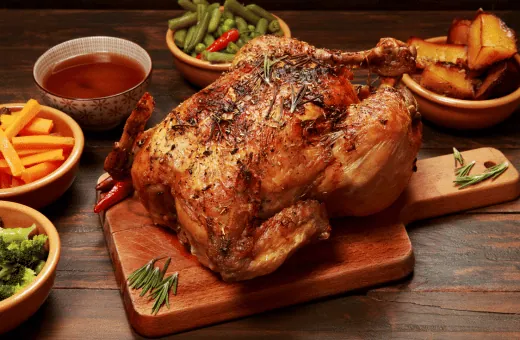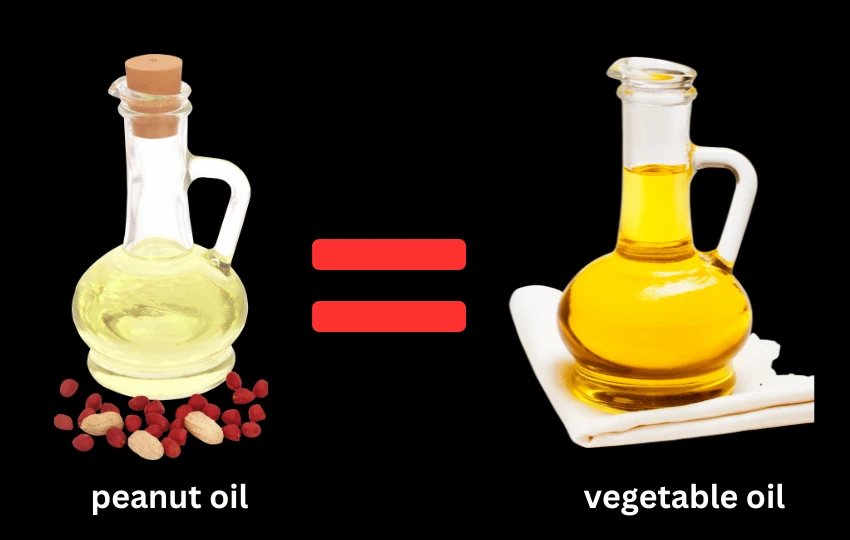When cooking, it’s not uncommon to find yourself in a position where you need a substitute for an ingredient.
It is mainly true regarding oils, as recipes often call for specific types.
Two types of oils you may find yourself substituting are peanut oil and vegetable oil. But can you substitute peanut oil for vegetable oil and vice versa?
In this blog post, we’ll explore this question in-depth and provide you with a detailed guide on how to substitute one oil for the other.
What is Peanut oil, and what does peanut oil taste like?
Peanut oil, known as groundnut oil or arachis oil, is a type of vegetable oil derived from peanuts.
The oil is normally used for cooking and frying due to its high smoke point (around 440°F or 227°C), which means it can be heated to higher temperatures without harming or producing harmful smoke.
This makes it an ideal choice for stir-frying, deep-frying, and sautéing.
Peanut oil has a mild, neutral flavor with a slight nutty taste. Its subtle flavor profile allows it to blend well with other ingredients without overpowering the dish.
In addition to its taste, peanut oil is appreciated for its ability to retain the natural flavors of the foods cooked in it.
There are different types of peanut oil, including refined, cold-pressed, and roasted. Refined peanut oil is the most common type used for cooking and has the mildest flavor.
Cold-pressed peanut oil retains more of the natural peanut flavor and has a slightly stronger taste.
Roasted peanut oil, made from roasted peanuts, has a deeper, richer, and more pronounced nutty flavor, which can be desirable in some dishes.
Uses of peanut oil in cooking
Peanut oil is a versatile cooking oil with a high smoke point and a mild, neutral flavor, making it suitable for a variety of cooking methods and dishes. Some common uses of peanut oil in cooking include:
1. Deep-frying: Due to its high smoke point, peanut oil is an excellent choice for deep-frying foods like chicken, fish, vegetables, and French fries. It heats up quickly and provides a crispy texture to fried foods without imparting a strong flavor.

2. Stir-frying: Peanut oil is commonly used in Asian cuisines, particularly in stir-frying dishes. Its high smoke point allows for quick, high-heat cooking, ensuring that the ingredients maintain their flavors and textures.
3. Sautéing: The mild flavor of peanut oil makes it suitable for sautéing vegetables, meats, and seafood without overpowering their natural flavors.
4. Baking: Peanut oil can be used in baking as a substitute for other oils or fats, such as butter or vegetable oil. It can help create a moist and tender texture in cakes, muffins, and other baked goods.

5. Salad dressings and marinades: Cold-pressed or roasted peanut oil can be used to prepare salad dressings and marinades, as their more pronounced peanut flavor can add a unique taste to the dish.
6. Grilling: Peanut oil can be used to coat grill grates, preventing food from sticking and creating a nice sear on meats and vegetables.
7. Roasting: You can use peanut oil to coat vegetables or meats before roasting them in the oven. The oil helps the food cook evenly and develop a crispy, golden exterior.

Now, let’s talk about when it’s appropriate to substitute peanut oil for vegetable oil
Peanut oil is an excellent choice for stir-frying, sautéing, and deep-frying dishes. It’s also perfect for cooking dishes that require a nutty flavor profile, such as Asian-style stir-fries, Thai curries, and Indian dishes.
However, if you’re making more delicate dishes such as cakes, cookies, or pastries, you may want to stick to using vegetable oil, as peanut oil’s distinctive flavor can overpower the rest of the ingredients.
When it comes to measuring and substituting peanut oil for vegetable oil in recipes, the conversion is straightforward. You must use the proper amount of peanut oil, as the recipe calls for vegetable oil.
So, if a recipe needs one cup of vegetable oil, you would use 1 cup of peanut oil instead.
However, keep in mind that peanut oil may be slightly thicker than vegetable oil, so you may need to adjust the recipe’s proportions slightly.
Can you substitute peanut oil for vegetable oil?
If the answer is yes, you can, but it’s important to be aware of a few things.
First, peanut oil has a stronger flavor than vegetable oil, so it may affect the taste of your dish. If you’re making something with a subtle flavor, like a cake or a salad dressing, you may not want to use peanut oil.
However, if you’re making something with a strong flavor, like a stir-fry or a curry, peanut oil can add a delicious nutty flavor.
Second, it’s worth noting that peanut oil is more expensive than vegetable oil. If you’re on a compact budget, you may want to stick with vegetable oil.
That being said, if you’re using a small amount of oil, the price difference may not be significant.
Third, you must be aware of the smoke point of the oil you’re using. As we mentioned earlier, peanut oil has a higher smoke point than vegetable oil.
If you’re frying or cooking at a high temperature, you may want to use peanut oil to prevent the oil from smoking. If you’re cooking at a lower temperature, either peanut oil or vegetable oil will work fine.
Fourth, it’s important to measure your oil properly. If a recipe calls for a typical type of oil and you’re substituting it with another type, you need to make sure you’re using the same amount.
For example, if a recipe needs 1/4 cup of vegetable oil and you’re substituting peanut oil, use 1/4 cup of peanut oil.
How much peanut oil is enough to use instead of vegetable oil?
When substituting peanut oil for vegetable oil in a recipe, you can use a 1:1 ratio, meaning that you can replace the same amount of vegetable oil with peanut oil.
For example, if a recipe needs 1 cup of vegetable oil, you can use 1 cup of peanut oil instead.
Both peanut oil and vegetable oil are neutral-flavored oils with similar properties, making them interchangeable in most recipes.
The main contrast between those is that peanut oil has a slightly nutty taste and a higher smoke point, making it particularly suitable for high-temperature cooking methods, such as frying or sautéing.
As always, be aware of potential peanut allergies when using peanut oil, as it may trigger an allergic reaction in some individuals.
Discover more: can I use vegetable oil instead of olive oil
Can you substitute peanut oil for vegetable oil in baking?
Yes, you can substitute peanut oil for vegetable oil in baking. Both oils have a mild, neutral flavor and similar properties, making them interchangeable in most recipes.
Peanut oil can help create a moist and tender texture in cakes, muffins, and other baked goods, just like vegetable oil.
When substituting peanut oil for vegetable oil in a recipe, use a 1:1 ratio, meaning that you can replace the same amount of vegetable oil with peanut oil.
For example, if a recipe needs 1 cup of vegetable oil, you can use 1 cup of peanut oil instead.
Remember that peanut oil is not suitable for people with peanut allergies, as it may trigger an allergic reaction.
If you’re baking for someone with a peanut allergy, consider using another mild-flavored oil like canola, sunflower, or safflower oil.
discuss the differences between peanut oil and vegetable oil
Peanut oil is extracted from peanuts and is known for its high smoke point (450°F). This makes it an ideal oil for frying and high-temperature cooking.
Vegetable oil, on the other hand, can be made from a variety of sources, including soybeans, sunflower seeds, and safflower seeds.
It has a milder flavor than peanut oil and a slightly lower smoke point (around 400°F). Because of its mild flavor, it’s often used in baking and sautéing.
It has a neutral savor and a high smoke point, which makes it ideal for frying and baking.
Peanut oil, on the other hand, is extracted from peanuts and has a nutty and sweet flavor. It is a higher smoke point, making it appropriate for high-heat cooking.
Learn more: Best Substitutes for Garlic Oil with Ratios
Conclusion on Can you substitute peanut oil for vegetable oil
In summary, substituting peanut oil for vegetable oil can be done in most cases. However, it’s important to consider the recipe you are making and its flavor profile.
Peanut oil works best in dishes that require a nutty flavor or high-heat cooking.
When measuring and converting, use the same amount of peanut oil as vegetable oil, but adjust the recipe’s proportions as necessary.
If cooking for someone with a peanut allergy, choose an alternative oil. Remember, cooking is about experimentation, so don’t be afraid to try new things and see what works best for you.
FAQs on can you substitute peanut oil for vegetable oil
Q1. What is similar to Vegetable oil?
Several oils are similar to vegetable oil in terms of their mild flavor and versatility in cooking. When looking for an alternative to vegetable oil, consider the following options:
1. Canola oil: Canola oil has a neutral flavor and a high smoke point, making it suitable for a variety of cooking methods, including frying, sautéing, and baking. It is a popular alternative to vegetable oil and is often used interchangeably in recipes.
2. Sunflower oil: Sunflower oil has a light, neutral taste and a high smoke point, making it a good choice for frying, sautéing, and baking.
3. Safflower oil: Safflower oil has a mild flavor and a high smoke point, making it a suitable substitute for vegetable oil in most recipes.
4. Grapeseed oil: Grapeseed oil has a mild, slightly fruity flavor and a high smoke point, making it a versatile option for cooking, frying, and baking.
5. Corn oil: Corn oil is another neutral-flavored oil with a high smoke point, suitable for frying, sautéing, and baking.
6. Soybean oil: Soybean oil is a common ingredient in vegetable oil blends and has a neutral flavor and a high smoke point, making it a good option for various cooking methods.
7. Peanut oil: Peanut oil has a mild, slightly nutty flavor and a high smoke point, making it suitable for frying, sautéing, and baking. However, be cautious when using peanut oil, as it may trigger an allergic reaction in individuals with peanut allergies.
When substituting oils, use a 1:1 ratio, replacing the same amount of vegetable oil with the alternative oil.
Keep in mind that the smoke points and flavors may vary slightly, which can affect the final outcome of your dish.
Q2. What is similar to Peanut oil?
When looking for an alternative to peanut oil, consider oils with a similarly high smoke point and mild flavor. Some suitable options include:
1. Canola oil: Canola oil is a versatile oil with a neutral flavor and a high smoke point, making it suitable for frying, sautéing, and baking. It is a popular alternative to peanut oil and can be used interchangeably in recipes.
2. Sunflower oil: Sunflower oil has a light, neutral taste and a high smoke point, which makes it a good choice for frying, sautéing, and baking.
3. Safflower oil: Safflower oil has a mild flavor and a high smoke point, making it a suitable substitute for peanut oil in most recipes.
4. Grapeseed oil: Grapeseed oil has a mild, slightly fruity flavor and a high smoke point, making it a versatile option for cooking, frying, and baking.
5. Corn oil: Corn oil is another neutral-flavored oil with a high smoke point, suitable for frying, sautéing, and baking.
6. Soybean oil: Soybean oil has a neutral flavor and a high smoke point, making it a good option for various cooking methods, including those requiring high heat.
7. Avocado oil: Avocado oil has a mild, buttery flavor and an exceptionally high smoke point, making it a suitable alternative for high-heat cooking methods, such as frying and sautéing.

